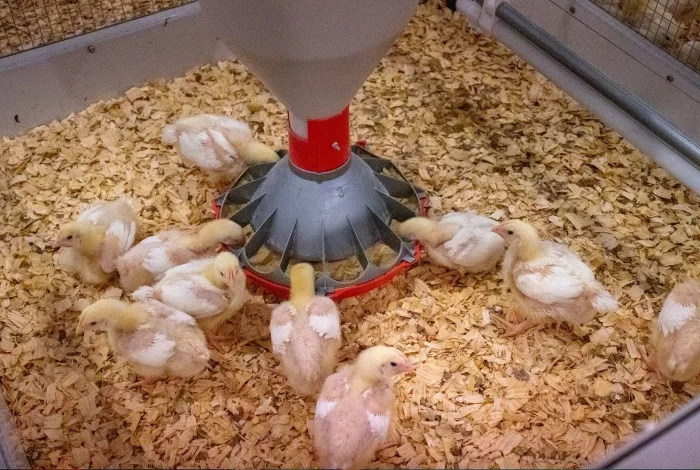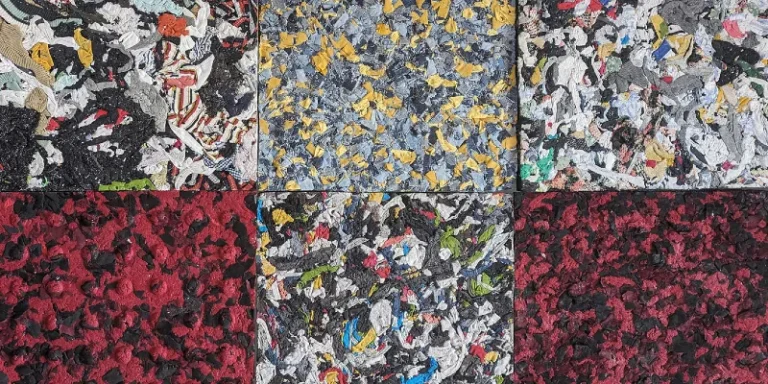Have you ever thought about lasers and chicken farming in the same sentence? Well, it’s time to shine a light on a groundbreaking approach in poultry farming.
Research from Iowa State University is turning heads with a novel idea: using specially designed laser lights as a form of environmental enrichment for broiler chickens. This isn’t just about adding some flashy lights to the coop; it’s a serious step towards boosting animal welfare and even improving meat quality.
We’re going to cover:
- How laser technology is revolutionizing broiler chicken welfare.
- The surprising health benefits for chickens exposed to these lasers.
- Why this could be a game-changer for poultry producers.
In truth, this is a practical and straight-forward concept that combines technology and animal science, where lasers are more than just a light show – they contribute to animal welfare while raising higher quality (and better tasting) chicken.
The Science Behind the Concept & Research
Picture this: laser lights dancing on the floor of a broiler pen, captivating the birds, and encouraging them to move more. It’s not science fiction; it’s solid science from Iowa State University.
By projecting dot-sized, randomly moving laser lights, researchers have found a clever way to stimulate broilers’ predatory instincts, nudging them into action.
This is crucial as broilers, particularly as they near market weight, tend to become more sedentary, which can dampen their quality of life.
The brains behind this innovative approach are Elizabeth Bobeck and Anna Johnson, associate professor of animal science and professor of animal behavior and welfare, respectively.
Collaborating with Signify, a livestock lighting company, they developed a second-generation laser device. With backing from heavy hitters like the U.S. Poultry and Egg Association and the U.S. Department of Agriculture, their study focused on how these lasers impact animal behavior.
Their findings? Rather than causing the birds to lose weight from excessive exercise, the lasers spurred more walking and positive behaviors. This led to improved weight gain and stronger bone density. It turns out, a little bit of light can lead to a lot of good.
Unexpected Benefits
Now, let’s talk surprises – the good kind. When the Iowa State researchers introduced lasers into broiler pens, they stumbled upon some pretty remarkable benefits. It wasn’t just a case of chickens chasing lights; these birds were actually getting healthier and happier.
Active and Appetizing
The broilers exposed to the lasers didn’t just walk; they walked with purpose. They moved more frequently and covered longer distances compared to their peers in the control group.
This extra activity had a surprising payoff: the birds actually gained more weight and showed improved feed efficiency. Who knew that a bit more exercise could lead to healthier, heftier chickens?
No Pain, All Gain
Here’s another twist. Despite their increased activity, the laser-engaged broilers didn’t suffer more physical wear and tear. We’re talking about fewer lesions, scratches, or blisters on their feet and bodies. It’s a relief to know that their extra steps came without extra stress.
In subsequent studies, the team focused on meat quality, stress responses, and overall performance in response to these laser-induced activities. One eye-opening discovery was that the broilers exposed to the lasers had lower levels of serum corticosterone, a stress hormone. It’s not just about moving more; it’s about moving happier.

Animal Welfare and Choice
When it comes to animal welfare, choice matters a lot. This principle was at the heart of the Iowa State University research on using lasers for broiler chickens. The team, understanding the importance of animal behavior and welfare, designed the laser system with the birds’ autonomy in mind.
Freedom to Choose
What’s really cool about these lasers is that they offer the broilers a choice. As Anna Johnson puts it, if the chickens want to interact with the laser, they can; if they prefer to chill out and ignore it, that’s fine too. This approach respects each bird’s individuality and comfort, which is a big win for animal welfare.
A Stress-Free Environment
One might wonder, do these lasers stress the birds out? The answer, happily, is no. In fact, studies showed that the broilers exposed to the lasers had lower stress levels. This is a significant finding because it suggests that lasers provide not just physical stimulation, but also a form of mental enrichment.
Designing for Welfare
The size and movement of the lasers mimic small insects, tapping into the chickens’ natural predatory instincts. The choice of red light was deliberate too – it’s captivating for the broilers and, crucially, safe for their eyes, which isn’t the case with other laser colors like green.
This thoughtful approach to design and implementation shows how technology can be used not just for productivity, but also for the wellbeing of animals.
4 Important Design and Safety Considerations
When it comes to integrating technology with animal welfare, design and safety are key. The laser devices used in the Iowa State University study are a prime example of this careful balance. Here’s a look at how these lasers are crafted to be both effective and safe.
- Attracting Attention, Safely: The lasers emit a red light, a deliberate choice for multiple reasons. Red isn’t only an enticing color for broilers but also a safer option for their eyes. Elizabeth Bobeck emphasized this point, noting that other laser colors, like green, could be more harmful due to their intense wavelengths. Safety for the birds (and humans) was a top priority.
- Mimicking Nature: The design of the lasers is quite clever. They don’t just randomly flash lights; their size and movement patterns are crafted to mimic small insects, something chickens are naturally inclined to chase. This detail is crucial as it taps into the birds’ instinctual behaviors, making the enrichment activity both engaging and natural for them.
- No Fuss Maintenance: Another advantage of these laser devices is their low maintenance. Unlike other forms of environmental enrichment for poultry, such as perches and platforms, these lasers don’t require cleaning and sanitizing between bird shipments. Anna Johnson pointed out that this not only reduces disease spread but also cuts down on labor, making it a practical choice for producers.
- Long-Term Utility: Lastly, the durability and self-sufficiency of these devices are a big plus. They might need the occasional software update or a tweak here and there, but largely, they run on their own. This ease of use and longevity make them an attractive option for poultry producers looking for sustainable solutions.
The thoughtful design and safety considerations of these laser devices demonstrate a harmonious blend of animal welfare, practicality, and technological innovation.

Practical Advantages for Producers
When it comes to poultry farming, practicality is just as important as innovation. The laser devices developed by Iowa State University researchers offer a host of practical benefits that could be a game changer for producers, big and small.
Ease of Maintenance
One of the biggest pluses of these laser systems is their low-maintenance nature. Unlike traditional environmental enrichments which require regular cleaning and sanitizing, these laser devices are pretty much set-and-forget. This aspect is particularly appealing in an industry where time and labor are precious commodities.
Reduced Labor and Disease Risk
The simplicity of these lasers also means less hands-on time for farmworkers and a lower risk of spreading diseases among the birds. This is a significant advantage, especially in large-scale operations where managing the health of thousands of birds is a complex task.
Versatility Across Operations
The beauty of these laser devices is their potential versatility. They’re not just suitable for large commercial confinements; they can also be a boon for smaller flocks and even different types of poultry. Whether it’s turkeys, laying hens, or broilers, the benefits of increased activity and improved welfare can be universal.
Attractive for Producers
As Anna Johnson notes, the laser system is designed to run autonomously with minimal intervention, which is incredibly appealing to producers. In an industry where efficiency and cost-effectiveness are key, tools that offer both without compromising animal welfare are invaluable.
These practical advantages, coupled with the proven benefits in animal welfare and meat quality, make laser enrichment devices an exciting prospect for the future of poultry farming.
Conclusion
In our journey through the innovative use of laser technology in poultry farming, we’ve uncovered some eye-opening insights. From improving broiler chicken welfare to offering practical benefits for producers, these lasers are more than just a novelty; they’re a beacon of progress in animal agriculture.
Here are the key takeaways from our exploration:
More To Discover
- Combatting Microplastic Pollution: How You Can Make Your Laundry Routine More Sustainable
- Yellowstone Faces ‘Zombie Deer Disease’ Threat, Scientists Warn of Human Risk
- After Shutting Down 4 Plants, Tyson Foods Debuts Advanced, Automatic $300M Poultry Processing Facility
- UK’s Chicken Industry in Crisis: 80 Million Deaths Point to Unsustainable Practices
- Health and Happiness: The use of lasers as environmental enrichment has shown to positively impact broiler chickens’ health, leading to more activity, better weight gain, and lower stress levels.
- Safety and Simplicity: The design of these laser devices focuses on both animal and human safety, with a user-friendly approach that makes them easy to maintain and operate.
- Broad-Spectrum Benefits: Beyond broilers, this technology holds potential for various types of poultry farming, offering a universal solution to enhance animal welfare and operational efficiency.
As we look to the future of farming, innovations like these lasers aren’t just a glimpse into what could be; they’re a step towards a more humane and sustainable approach to animal agriculture.
It’s a reminder that with the right blend of technology and compassion, we can make significant strides in improving the lives of farm animals and the people who care for them.
For those intrigued by the intersection of technology and animal welfare, the journey doesn’t end here. Exploring further innovations in sustainable farming practices could be your next exciting read.
The fusion of tech and animal care is just beginning, and who knows what other groundbreaking developments are on the horizon? Regardless, we’ll keep you updated!















